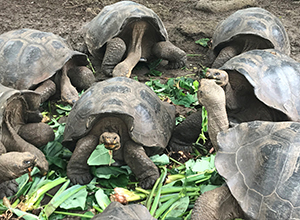A Partnership in the Galapagos
.jpg) |
|
UAlbany biologist Wendy Turner was thrilled with the species she saw during a site visit to the Galapagos Islands. |
ALBANY, N.Y. (Sept. 25, 2018) – For Mary Ellen Mallia, it was the tortoises and sea lions. For Wendy Turner, it was the attraction of the Galapagos Islands.
“The Galapagos is the holy grail for someone who studies ecology and evolutionary biology,” said Turner, assistant professor of Biological Sciences.
Mallia, Turner and Carrie Wojenski of the Center for International Education and Global Strategy recently joined President Havidán Rodríguez and his wife, Rosy Lopez, on a site visit to the Universidad San Francisco de Quito (USFQ) in Ecuador and its research center in the Galapagos.
Their mission: to help strengthen ties between the two institutions and to explore possibilities for faculty collaboration as well as student study, research and internships. While at USFQ, Rodríguez delivered the Chancellor’s Lecture.
“Visiting USFQ was another demonstration of our commitment to internationalization and to expanding our global collaborations,” said Rodríguez. “It was an honor to participate in their 30th anniversary celebration, and to continue building a sustainable partnership that benefits the research and academic enterprises of both institutions.”
Wojenski, associate vice provost for Global Academic Programs, said USFQ is a new university partner, and UAlbany’s first partner in Ecuador. “They are a well regarded, well ranked institution with one-of-a-kind research facilities in the Galapagos and the Amazon,” she said.
Much of the work at the Galapagos Research Center and the Tiputini Biological Station in the Amazon is focused on sustainability, which is UAlbany Director of Sustainability Mallia’s area of expertise.
 |
|
The tortoises were a main attraction. |
“Despite being thousands of miles apart with different climates, economic and political systems, we can still examine several common problems such as access to clean water and getting the community engaged in sustainability practices,” Mallia said. USFQ is a member of the same professional organization for sustainability as UAlbany, and completes its assessment tool, called Sustainability Tracking, Assessment and Rating System (STARS).
“My focus is mostly on the student experience aspect at this point but based on the activities we were shown there, I could see potential research projects around weather data, an archaeological dig, water quality and consumption and its effect on public health and sustainable tourism, to name a few,” Mallia said.
UAlbany is home to the largest concentration of atmospheric, climate and environmental scientists in New York State, and one of the largest in the nation.
Mallia said she is “already promoting the study abroad opportunities to the sustainability students.” UAlbany and USFQ will swap STARS reports in Novembers and Mallia will develop a sustainability-themed faculty-led curriculum for future study abroad programs.
As a result of the site visit to Ecuador, said Wojenski, “our staff will now be able to advise prospective education abroad and research abroad students on the opportunities available at USFQ, as well as better prepare and support them prior to departure.”
Turner, whose research in Namibia on naturally occurring anthrax infections in zebra received widespread attention, was happy to see how keen scientists in Quito are to collaborate. She also was pleased by the infrastructure she found and support for visiting scientists’ students.
“Having that level of support makes it much easier to work in such a remote area,” she said.
Turner is already planning to use her photos and newfound knowledge in her teaching.
“The Galapagos figures in every course in Ecology and Evolutionary Biology, so it’s a great opportunity to share more about the system. I’d like to encourage our students to do study abroad there, and I’m interested in developing a UAlbany course,” Turner said.
On a personal note, Turner was surprised at how family-friendly the Galapagos and Quito were.
“I can easily see traveling there with my family for research and teaching. That’s not something you find everyplace you go, and it was certainly a shock to see playgrounds on every corner in the village we stayed in on San Cristobal,” she said.
![]() For more news, subscribe to UAlbany's RSS headline feeds
For more news, subscribe to UAlbany's RSS headline feeds
A comprehensive public research university, the University at Albany-SUNY offers more than 120 undergraduate majors and minors and 125 master's, doctoral and graduate certificate programs. UAlbany is a leader among all New York State colleges and universities in such diverse fields as atmospheric and environmental sciences, business, education, public health,health sciences, criminal justice, emergency preparedness, engineering and applied sciences, informatics, public administration, social welfare and sociology, taught by an extensive roster of faculty experts. It also offers expanded academic and research opportunities for students through an affiliation with Albany Law School. With a curriculum enhanced by 600 study-abroad opportunities, UAlbany launches great careers.


